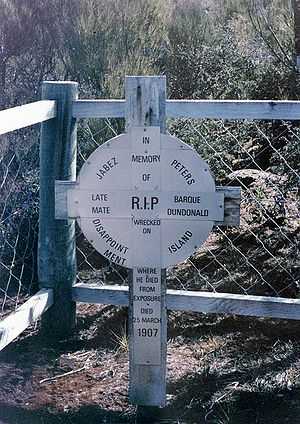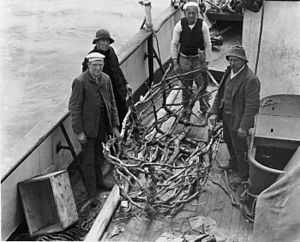Dundonald (ship)
 A contemporary print of Dundonald | |
| Career (UK) | |
|---|---|
| Name: | Dundonald |
| Owner: | Kerr, Newton & Co., Glasgow |
| Builder: | Workman, Clark & Co. Ltd., Belfast |
| Launched: | 1891 |
| Fate: | Wrecked and sunk, 7 March 1907 |
| General characteristics | |
| Type: | Barque |
| Tonnage: | 2,205 GRT |
| Length: | 284 ft 2 in (86.61 m) |
| Beam: | 42 ft (13 m) |
| Depth: | 24 ft 4 in (7.42 m) |
| Sail plan: | Full-rigged ship |
| Crew: | 28 |
The Dundonald was a steel, four-masted barque of 2,205 tons, which was launched in Belfast in 1891. She was shipwrecked in 1907 in the New Zealand Subantarctic Islands. Only 15 of the 28 crew survived and were rescued seven months later by a scientific expedition.
Shipwreck
After setting sail from Sydney, Australia on 17 February 1907, bound for Falmouth with a cargo of wheat, she was forced onto rocks during a squall and sank on 7 March on the west of Disappointment Island, 5 miles north west of the Auckland Islands, 180 miles south of New Zealand.[1]
Shipwrecked crew
Only 17 members of the 28 crew managed to escape the wreck to shore. One man, Walter Low, made the shore but slipped off the cliff back into the sea and was never seen again.[2] Another, the mate Jabez Peters, died of exposure on 25 March 1907, eighteen days after the disaster.[3] He was buried in the sands, but in November 1907, members of the Hinemoa's crew exhumed his body and re-interred it at the Hardwicke cemetery at Port Ross, in Erebus Cove, in the Auckland Islands; Peters' father and brother were also lost at sea in New Zealand waters.[citation needed]

- Captain J.T. Thorburn - drowned
- James Thorburn, the Captain's son - drowned
- Jabez Peters, first mate - died of exposure on the island
- Daniel McLaughlin, second mate - survived
- Karl Knudsen, third mate - survived
- William Smith, steward - drowned
- Thomas Crawford, sailmaker - drowned
- Edward Lee, carpenter - drowned
- Charles Eyre of London, able bodied seaman - survived
- Arthur Iviney, ordinary seaman - survived
- John Judge of Ireland, a Santiago marine - survived
- Albert Roberts, cabinboy - survived
- Alfred Finlow (also known as Finlon)[6] - survived
- John Gratton - survived
- Harry Walters - survived
- John Puhohe - survived
- Herriman Querfelt - survived
- Robert Ellis of Adelaide, Australia - survived
- Jack Stuart (reported as Stewart) of Waikato, New Zealand - survived [7]
- John Trotton - survived
- Michael Pul (also known as Michael Poole),[2] a Russian Finn - survived
- Sam Watson - drowned
- Carl Anderson - drowned
- Holdersen - drowned
- Immanuel Naveati - drowned
- James Cromarty - drowned
- H. Larquer Boloom - drowned
- Walter Low - slipped off the cliff back into the sea after reaching shore on the night of the shipwreck and was never seen again[2]
Survival

The survivors lived for seven months on Disappointment Island, a barren outcrop three miles long and two miles wide. For the first three days they ate raw mollymawks until their supply of matches dried enough to get a fire going. They kept the same fire burning for the duration of the shipwreck, burrowed into the ground for shelter. The island had limited timber and the canvas tent could not withstand the constant storms so they improvised by digging into the ground and roofing over with sods and shelter.[8] The survivors also improvised clothes and tools from materials salvaged from the wreck or from the seals and limited trees they found on the island.
The crew knew that there was a food depot on Auckland Island. They built a coracle and oars from branches and ship's canvas to try to reach it. The first attempt in August landed three men on the main island eight kilometres away but they failed to locate a depot. The coracle was smashed on launching in the second attempt. The men built another coracle and, in October, four of the crew landed on Auckland Island. The coracle was smashed on landing.[9] The four crew hiked their way through rough terrain to reach Port Ross where they located the food depot and a boat. The boat had no sails, so the castaways cut up their clothes for sails and ferried the remainder of the 15 men to Ross Harbour.[1]
Rescue
They were eventually rescued by a New Zealand Government steamer, the NZGSS Hinemoa captained by John Bollons. On 16 November 1907, the Hinemoa arrived at Port Ross to refresh the depot and to drop off some members of the 1907 Sub-Antarctic Islands Scientific Expedition. On arriving at the port it was noticed that the Government depot flag was flying at half mast - an indication of a shipwrecked crew. Captain Bollons launched a boat and, after landing, found the castaways.
Captain Bollons took only one of the crew off the island at that point. He asked Charles Eyre to act as cook for the expedition group intending to stay on Campbell Island for the remaining outward leg of the voyage to Bounty and Campbell Islands. The rest of the castaways were supplied with additional stores and were told the Hinemoa would call for them on the return trip.
When the Hinemoa returned, the scientists on board asked the crew to bring the remaining coracle and various other articles with them to New Zealand.[10] The coracle was exhibited at Canterbury Museum with the funds raised for the benefit of the survivors.[6] In addition to these funds the survivors also received money from the Shipwreck Relief Society.
References
- ↑ 1.0 1.1 ""Dundonald" Wrecked on the Auckland Islands in 1907". Retrieved 19 June 2010.
- ↑ 2.0 2.1 2.2 "Shipwreck at the Auckland Islands". Ashburton Guardian. Volume XXIX, Issue 7349, 2 December 1907. p. 3. Retrieved 19 June 2010.
- ↑ "Image of the Crew of the ’Dundonald’". Retrieved 19 June 2010.
- ↑ "Wreck of the Ship Dundonald". The Colonist, Volume L, Issue 12105, Page 2. 2 December 1907. Retrieved 19 June 2010.
- ↑ "A Surprise Party". Feilding Star, Volume II, Issue 435, Page 4. 2 December 1907. Retrieved 19 June 2010.
- ↑ 6.0 6.1 "The Dundonald Enquiry". Grey River Argus, Page 3. 5 December 1907. Retrieved 19 June 2010.
- ↑ "Commemorative marker". Retrieved 25 October 2013.
- ↑ "Image of the Huts of the ’Dundonald’ castaways, Disappointment Island". Retrieved 19 June 2010.
- ↑ "A Tale of Shipwreck, Fortitude and Endurance". 2001. Retrieved 25 June 2010.
- ↑ "Image of some of the Dundonald survivors and coracle". Retrieved 19 June 2010.
External links
Additional sources
| Wikimedia Commons has media related to Dundonald. |
- The Wreck of the Dundonald by Albert Roberts. Recorded in 1976. 44"
- Last of the Windjammers, Vol. 2, by Basil Lubbock.
- The Otago Witness carried photos of the survivors on 18 December 1907.
- The Annual Dog Watch No. 16 [1959] Wreck of the Dundonald by Capt. W.E. Eglen
- The Castaways of Disappointment Island by the Rev. Herbert Escott Inman.
Coordinates: 50°36′29″S 165°57′17″E / 50.607938°S 165.954817°E